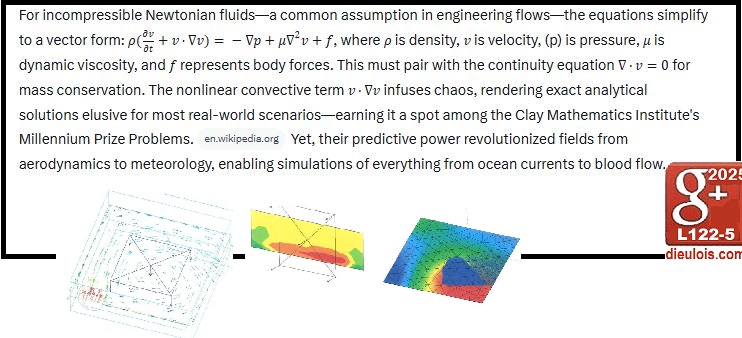by FPDieulois :: 2025-11-07
Foundations of Fluid Motion: Deriving the Navier-Stokes Equations
The Navier-Stokes equations stand as the cornerstone of fluid mechanics, encapsulating the complex dance of viscous fluids in motion.
Named after Claude-Louis Navier
and George Gabriel Stokes, who independently formulated them in the 19th century,
these partial differential equations emerged from Newton's second law applied to fluid elements.
At their core, they balance momentum conservation, accounting for pressure gradients, viscous stresses, gravitational forces, and external influences.

The Computational Revolution: Numerical Solutions via CFD
Directly solving the Navier-Stokes equations analytically is feasible only for simplified cases
like Poiseuille flow in pipes or Couette shear between plates.
For turbulent, three-dimensional flows, engineers turn to Computational Fluid Dynamics (CFD),
discretizing the equations using methods like finite volume (FVM) or finite element (FEM) to approximate solutions on computational grids.
Turbulence modeling—via Reynolds-Averaged Navier-Stokes (RANS) or Large Eddy Simulation (LES)
—closes the underdetermined system, capturing averaged behaviors without resolving every eddy.
This numerical prowess exploded with computing power in the 20th century.
Early efforts at Los Alamos in the 1940s used rudimentary machines for 2D flows,
evolving into NASA's ARC3D and OVERFLOW codes by the 1970s.
Today, CFD software democratizes these equations, allowing iterative "what-if" designs that slash prototyping costs and time.

ANSYS: Industrial-Scale Mastery of Navier-Stokes
Among CFD titans, ANSYS Fluent exemplifies the equations' industrial might.
Fluent solves the full compressible Navier-Stokes set using FVM,
excelling in multiphysics integrations like heat transfer and chemical reactions.
Its preconditioned solvers handle everything from subsonic Couette flows—where exact solutions validate simulations
—to hypersonic reentries.In electronics cooling, ANSYS simulates airflow over heat sinks, predicting hotspots in PCBs under load.
For instance, engineers model conjugate heat transfer, coupling fluid Navier-Stokes solutions with solid conduction
to optimize fin spacing and material choices, ensuring components stay below 85°C.
In fan design, Fluent's Multiple Reference Frame (MRF) approximates rotating blades, solving modified Navier-Stokes
with Coriolis terms to forecast pressure-volume curves without full transient meshes.
This slashes computation time by 90%, vital for iterating axial fans in data centers where airflow must combat kilowatts of heat.

SolidWorks Flow Simulation: Seamless CAD-Embedded CFD
For design-centric workflows, SolidWorks Flow Simulation embeds Navier-Stokes
solving directly into CAD environments, using RANS and Favre-Averaged variants for turbulent flows.
Its "SmartCells" technology automates meshing near walls, resolving boundary layers without manual y-plus tweaks
—ideal for novices tackling viscous effects.
In electronic cooling, Flow Simulation shines for rapid prototyping of enclosures with fans.
Users define rotating regions for impellers, letting the software solve momentum equations to visualize velocity fields and temperature gradients around ICs.
A typical setup for a laptop chassis might reveal recirculation zones behind heat pipes, prompting baffle additions to boost cooling by 15%.
For fans, it predicts noise via turbulence intensity from Navier-Stokes-derived shear stresses, aiding quieter server designs amid rising data demands.

Moldflow: Navier-Stokes in Polymer Precision
While primarily for injection molding, Autodesk Moldflow leverages generalized Navier-Stokes
for non-Newtonian fluids, incorporating viscoelastic models to simulate molten polymer flow.
It solves coupled continuity and momentum equations, accounting for shear-thinning viscosity
that defies simple laminar assumptions.
In electronics manufacturing, Moldflow optimizes potting compounds or overmolding for circuit boards,
ensuring void-free encapsulation that enhances thermal dissipation. By iterating fill patterns via CFD,
designers minimize weld lines—stress concentrators—while predicting cool-down via energy equations tied to Navier-Stokes.
This prevents warpage in LED housings, where uneven cooling could spike junction temperatures beyond safe limits.
Fans and Electronic Cooling: Navier-Stokes in Action
Navier-Stokes equations are indispensable for fans, the workhorses of electronic thermal management.
Axial and centrifugal fans propel air through chassis, but their blades induce swirling wakes that CFD must capture.
Using MRF or sliding meshes, software solves unsteady RANS forms,
adding centrifugal accelerations to the momentum balance for rotating frames.
Simulations reveal stall angles or tip vortices, optimizing blade pitch for 20% higher efficiency in EV battery packs.
In electronics cooling, these tools tackle hotspots from 5G chips to EVs.
For a server rack, ANSYS might model 40 fans exhausting 10,000 CFM, using Navier-Stokes to balance pressure drops
across perforated panels and predict 5°C reductions via vortex generators.
SolidWorks Flow aids consumer gadgets, simulating conjugate flows over GPUs where air speeds hit 5 m/s,
ensuring fans don't overwork against backpressure.
Moldflow complements by designing molded fan housings that minimize flow separation, cutting noise in quiet office PCs.
These applications underscore Navier-Stokes' versatility: from microscale boundary layers in heat sinks to macroscale data center airflow.
As hardware densifies—think quantum chips generating 1 kW/cm²—CFD-driven optimizations will be crucial,
blending AI surrogates with full-fidelity solves for sustainable cooling.

< B > My Personal Blog < B > List of all my Blog posts < B >
(c)FPe COPYRIGHT @FPDIEULOIS 2025